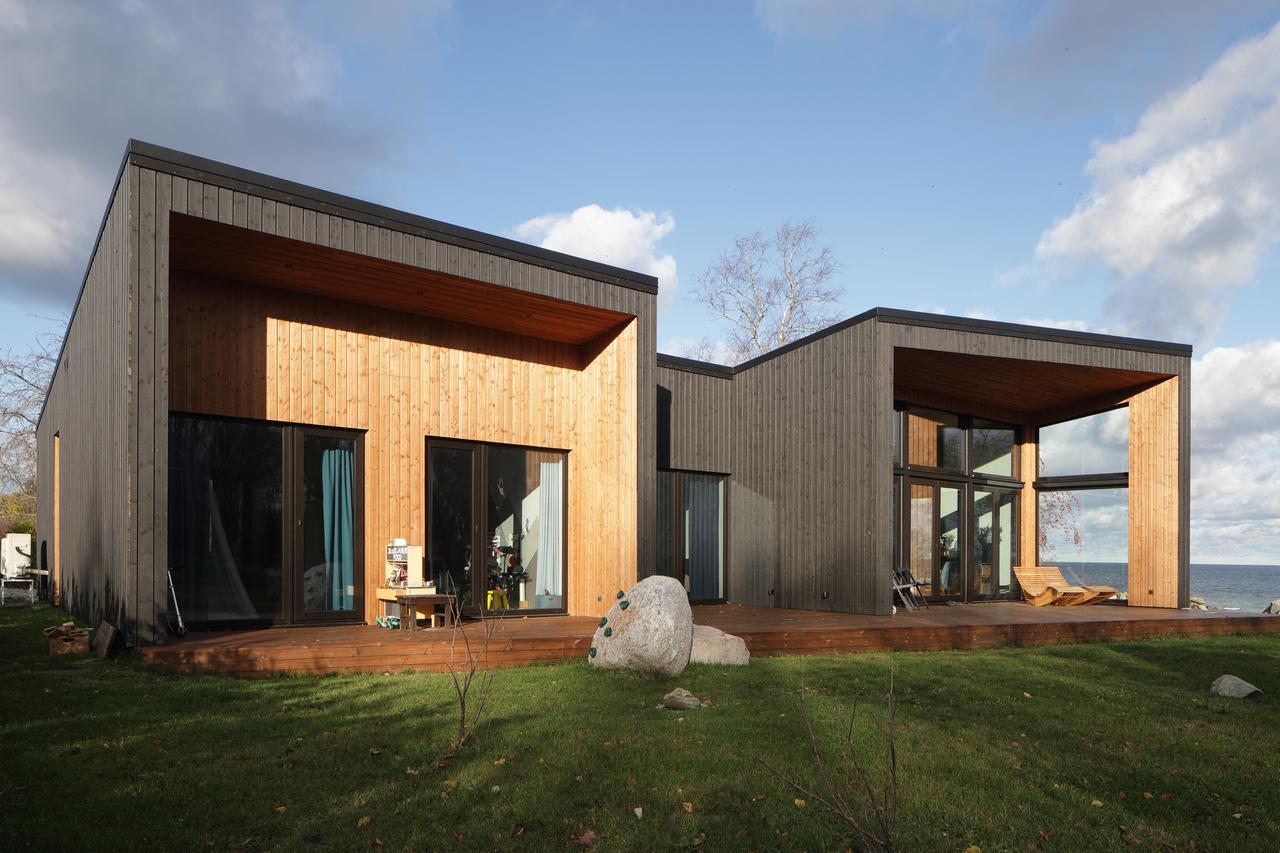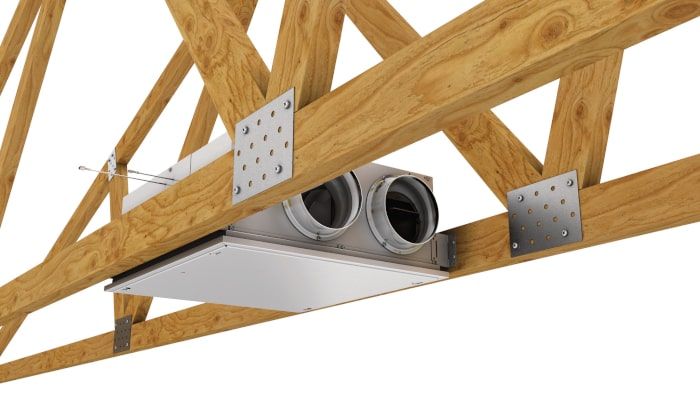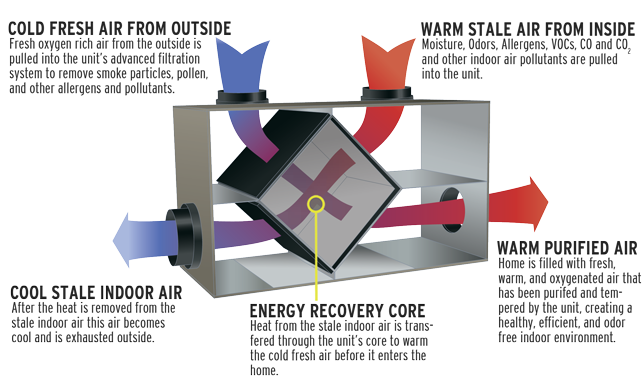They say eco-friendly homes must be airtight.
You might be wondering how is it possible to live in a closed box, with no fresh air ever coming in.
That'd be a legit concern... if it really was true that no fresh air is ever coming in. But it isn't.
Eco-friendly houses have "lungs".
The ventilation system is the lungs of a modern home.
In this article, I explain the most important aspects of this system and I give you the information you need to start planning your own energy-efficient ventilation system.

One of the main requisites of eco-friendly homes is to be energy-efficient and to be air-tight.
The entire concept if air-tightness does not mean we don't want new air in the house, it simply means we want to be in control of the air exchange (because uncontrolled air exchange is a health hazard and it is extremely energy inefficient).
So, since the house is air-tight, we need something to control the air exchange.
That something is the ventilation system.
The ventilation system
In its most basic form, a ventilation system is composed of a ventilation unit and a series of ducts.
The ducts reach each room of the house and connect them with the ventilation unit.
The job of the ventilation unit is to suck "used" air out of the house (extract exhaust air) and replace it with the same amount of fresh air coming from the outside.
It's a very simple task but it's a task that goes on 24/7, even when you are not in the house.
It's exactly like breathing for us humans.
By all means, the ventilation system is the lungs of your home.
The fresh air provided by the system guarantees the proper level of oxygen in each room of the house and it plays a big role in indoor comfort.
Also, a good ventilation system can keep the humidity level under control and this helps to maintain a perfect indoor climate.

The ventilation unit is pretty simple: there are just 2 electric motors.
One motor runs the exhaust fan, one motor runs the supply fan.
The ventilation unit runs entirely on electricity.
Exhaust and supply
The ventilation system is designed to extract exhaust air from humid rooms and supply fresh air to the other rooms.
Humid rooms are:
- kitchen;
- toilets;
- bathrooms;
- saunas;
- laundries;
- technical rooms.
In these rooms humidity (and smell) build up quickly and need to be removed fast.
All the other rooms are places where people spend time (living room, bedrooms, ...) and where the oxygen level must be always appropriate.
That's why the ventilation system supplies fresh air to those rooms.

The dimensioning of the system must be done by a professional.
In fact, for the system to work correctly, exhaust and supply must move exactly the same amount of air.
Failure to do so would result in putting the house under pressure (positive or negative pressure) and forcing air to leak into tapes and membranes.
This is an absolute NO-NO-NO.
Side note: not only the system must be designed correctly (the size of the ventilation unit has to be chosen taking into account the total volume of air to move in one hour + the size of the ducts has to be chosen taking into account the volume of air to move in one hour in the specific room that duct is reaching)... but the system has to be calibrated as well.
Before starting living in the house, the company that designed the system and made the installation, should come to measure the actual air volumes that are running through the system and fine-tune outlets and inlets to make the numbers sum up correctly.
Heat exchanger
You might have noticed we are talking of throwing air out of the house 24/7.
That air has a temperature of 20-21°C (68-70°F) and we spent money to heat it.
How's throwing it out a good idea for energy-efficiency?
I'm glad you asked... cause it is not a good idea at all.
This is why a good ventilation unit needs to have a critical component: a high-efficiency heat exchanger.
We are now talking about an HRV system (Heat Recovery Ventilation).
The heat exchanger takes energy (heat) out of the exhaust air before it gets out of the house and transfers it to the supply air while it enters.
It does that without the two streams of air mixing together.

The efficiency of heat transfer depends on how good the heat exchanger is.
The Passivhaus Standard was the first to embrace the concept of recovering energy from the air we throw out of the house.
The PH Standard sets the minimum efficiency of the exchanger to 75%.
I would recommend striving to get the best HRV unit you can afford (remember the thing is working 24/7).
If I were to buy a new HRV for my home, I would set the bar at least 90% efficiency.
Here is a list of HRV units certified by the Passivhaus Institute.
Filters
One of the side benefits of having control over the air exchange in the house is the possibility of filtering the air supply.
Filtered air greatly improves indoor comfort because:
- it lets in fewer dust particles;
- it lets in fewer allergens (dust itself, polylines, ...).
Filters are also important to make sure the ducts remain clean.
In turn, this helps to avoid condensation and the subsequent formation of mold.
The degree of filtering you need depends on your own sensibility to dust and allergens... however, I'd recommend going with the best filters your HRV unit support.
Noise reduction
Indoor comfort is important for an eco-friendly home.
Preserving silence is an important part of that comfort.
Having 2 motors running 24/7 in a closed box can generate quite a bit of noise.
For this reason, there are noise dampeners that can (and must) be installed onto the ducts.
Noise dampeners must be designed into the system where appropriate and added if necessary during the fine-tuning.
The maximum noise level for the system is set in the PH Standard to 25db.
Pre-heating
Pre-heating of the supply air is often overlooked and it may cause big problems in cold climates.
By pre-heating, we mean heating up the supply air before it reaches the heat exchanger inside the unit.
The purpose of this practice is to avoid the temperature of the exhaust air in exit from the exchanger to drop below freezing temperature.
In fact, if you were to suck in air at -20°C and push out air at +20°C, the temperature of the exhaust air exiting the heat exchanger would be exactly 0°C (freezing temperature).
During the normal functioning of the heat exchanger, the humid air extracted from the house condensates on the surface of the exchanger and drops into a collector that drains it away. That's perfectly fine.
When the outdoor temperature gets in the neighborhood of -20°C (can be as low as -15°C, depending on the HRV unit and on the efficiency of the exchanger), the droplets of condensate on the very exit of the heat exchanger starts to turn into ice and will quickly clog the entire exchanger.
This will bring the HRV system to a halt.
To resume the system after such a stop, one must remove the heat exchanger and defrost it manually (bathtub and hairdryer).
This is NOT something you want to happen in your home!
While pre-heating the supply air reduces greatly the efficiency of the heat exchanger, you really have no choice if the outdoor temp in your area drops normally below -15°C for prolonged periods of time.
Since this is not the case for most areas, pre-heating systems are sold separately from the main HRV unit.
Make sure your HRV expert is really an expert and can help you dimension your system correctly.
Post-heating
Cold climate poses a serious challenge to ventilation systems.
In fact, not only you have pre-heat the air when it is too cold outside, but you also might have to post-heat it.
The point here is that you don't want cold (or coldish) air to be blown inside your house from the ventilation system.
If the temperature difference between the indoor air and the air supply exceeds 4°K, the colder supply air will not mix with the air in the house but drop to the floor instead.
This would create a "cold feet" sensation that is very unpleasant.
It will totally destroy indoor comfort.
For this reason, the air supply has to be heated if its temperature (when getting out of the heat exchanger) is less than 17°C.
Again, the technical solution to address this issue will depend on your HRV unit.
You need to make sure who designs your HRV system takes this into account and can guarantee you won't get cold air in the house in the coldest days of winter.
Sidenote: blowing cold air into the house will also cause condensation at the air inlets and into the ventilation ducts.
This is something you really want to avoid cause condensation leads to mold and to health issues.
Pre-cooling
We spoke at length of cold climates.
It is time to spend a few words about hot ones.
In the hot days of summer, in some locations, the air outside can reach (and pass) 40°C.
This is way above the maximum temperature you want to have in the house.
Sidenote: according to the Passivhaus Standard and other major Standards, the comfortable indoor temperature is raised to 25°.
If the outside air is 15°K higher than the one you want to have in the house, your only option is cooling.
But do you really have to use a heat-pump?
Nop, you can actually cool the air supply of your HRV system BEFORE it gets into the house.
You could be blowing in a refreshing 20°C air-stream... think about that :)
The trick here is simple: a water-to-air heat exchanger is placed on the supply main duct.
The water in the exchanger has to be at a temperature in the range 15-20°C (a pump will then circulate it ate the right speed to adjust the temperature of the air supply after the exchanger.)
When the hot supply air meets this exchanger, it starts to cool down to the temperature of the water in the exchanger.
While doing so, it drops most of its humidity content into the exchanger, which drains the condensate away.
The refreshed supply air exits the exchanger and enters the main supply ducts. DONE.
Sidenote: in summer your HRV unit does not need the high-efficiency heat recovery exchanger and that piece of hardware has to be removed from the unit.
If the summer outdoor temperature in your area tops up to 30°C, you most likely don't need any pre-cooling.
How best approach HRV in your house
As you can see, the HRV system is quite complex and you definitely need a specialist to assist you with it.
Here are a few key pieces of information you must keep in mind when dealing with the HRV system:
- Air-tightness
to use a high-quality HRV system, your house needs to be totally air-tight.
Failure to comply with this will result in the random behavior of the HRV system. - Design and space allocation
the location of ducts and the position of the HRV unit has to be planned during the architectural design phase.
A basic layout of the system must also be drafted during this phase, as well as the overall air-tight layer of the house. - HRV unit
the selection of the HRV unit is of crucial importance.
You must pick a model that has enough capacity to move the correct volume of air for your home.
The heat exchanger must have very high efficiency (recommended 90+%).
It must be possible to equip it with very good filters.
Automated control of the unit based on time of the day, time of the year, and outdoor temperature, is a plus.
Sidenote: if you live in a location where the temperature in winter drops below 15°C, you must use pre-heating on the air supply! - Installation
The HRV system is pretty easy to install but the installation must be executed carefully. Details are important.
A bad connection in the ducts can generate leaks and noise and erratic behavior of the entire system.
The PH Standard sets very strict rules for the installation of the HRV system. I suggest you follow those in order to avoid surprises.
Sidenote: it is a good idea to have your Project Manager to monitor closely the execution of the installation of the HRV system. - Maintenance
Maintenance is almost always overlooked.
Although most HRV systems are easy to maintain, you need to schedule the yearly maintenance and have it carried out.
The last thing you want is for your HRV system to stop working in the middle of the winter cause your filters are full or because the dust in the exchanger clogged the passage of air... and believe me, if it has to happen it will happen on the coldest day of winter (been there).
The maintenance is as easy as cleaning (or replacing) the filters, removing and cleaning the exchanger, cleaning the inside of the ventilation units.
Every few years also the ducts need cleaning. However, if you use good filters, the need for cleaning the ducts is reduced by a lot.
Conclusion
Guaranteeing the correct air exchange in your home is very important.
The HRV system is a complex one, although its individual components are pretty simple.
Since the system must work 24/7 throughout the year, it is very important that it is correctly dimensioned and well maintained.
A faulty HRV system will cause the indoor comfort of your house to drop dramatically... and this would quickly affect the wellbeing of your family.
If you live in an area where the temperature range is withing -15°C to +30°C throughout the year, then you are in luck as you do not need any pre-cooling, pre-heating, or post-heating.
In any case, You always need an expert for dimensioning your system.
Do your homework when it comes to get the ventilation right and invest in the HRV system enough money to never have any regret.
If you feel like you need help to sort things out for your project, you can reach out to us for help.




